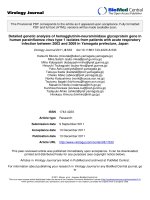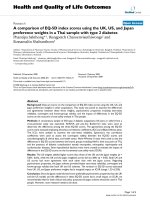1011 pref
Bạn đang xem bản rút gọn của tài liệu. Xem và tải ngay bản đầy đủ của tài liệu tại đây (26.36 KB, 2 trang )
Preface
xv
Preface
The first edition of this book was written in 1992. At that time it was not obvious that the
pace of filler development was accelerating. In the intervening 6 years, much has been done
and there are many new filler products on the market and under development. These have
opened new and exciting business opportunities which formulators and marketing
managers have exploited in a wide range of new products. The new edition of the book
covers many of these developments and discusses the potential for future research and
development. What was dealt with only as a passing reference in the first edition now
requires a chapter to do it justice.
Six years ago there was less pressure than there is now from environment regulations
and activists to limit waste, conserve non-renewable resources, deal with fire and explosion
risks, shield a wide variety of energy sources, reduce harmful emissions, and recycle scrap.
Today, these issues are the basis of stringent requirements. In addition, products must be
lighter, stronger, odor free, look good, and be easy to clean. Plastic products are meeting
these challenges and, in doing so, are even able to look and feel like natural products.
Fillers have played a major role in meeting these ever more demanding requirements.
The introduction of plastic components in automobiles has been rocky. Early attempts to
use plastics failed because they lacked strength and weather resistance. Fillers have been
responsible for transforming these same plastics to strong durable automotive components.
Portable computer have become the truly portable laptop of today due in large part to the
lighter, strongly reinforced plastics that are now available. The cases not only look smooth
and sleek, they provide shielding from the electromagnetic radiation that used to prevent the
use of computers on aircraft in flight. Where filler used to be though of as a means to lower
cost of a plastic part they now contribute to the unique properties that sophisticated users
demand. In fact, many fillers now cost more than the polymers that they are added to. But
such additions make economic sense because of the value that the filler brings to the
formulation.
In this book we hope to have dealt with many of these immense opportunities which
these new developments have created. We have examined the current technical literature in
detail and it is clear that there is almost unlimited future potential to save time, money, and
energy while developing new products with unparalleled performance. It would be nice to
think that this book would be read cover to cover but we know that most people will skim
through it to find the sections that apply to their work or area of interest. We have attempted
to structure the book to make it useful both as a textbook and as a series of monographs. It
has been categorized in a way that should match the interests of those with specific needs.
Where technologies are shared by more than one application we have duplicated the same
information in different formats in two or more sections.
The table of contents provides a clear guide to where specific subject material can be
found. Wherever possible we have referenced the original source and we encourage
researcher to go to these for the additional details that may provide the clarity and depth that
their work may need. We would have liked to include more specific examples and
explanations but we believe the book should not run to several thousand pages. However,
xvi
Preface
this issue will be addressed by the end of 1999 when we will publish the information on
specific grades of fillers on CD-ROM. It will contain much more data on specific fillers and
products, data which can be searched and compared electronically.
We deem it a great privilege to have had the opportunity to report on the extensive data
from researchers and filler manufacturers and I wish to acknowledge their kind help and
many personal efforts to assist me in this project. I am grateful to those who have worked
hard and long to generate the data and ideas that have advanced our understanding of filler
properties and composite performance. They continue to make this field of technology
increasingly more fascinating. I would also like to thank John Paterson who read and
corrected much of the manuscript.
George Wypych
Toronto, October 1998









